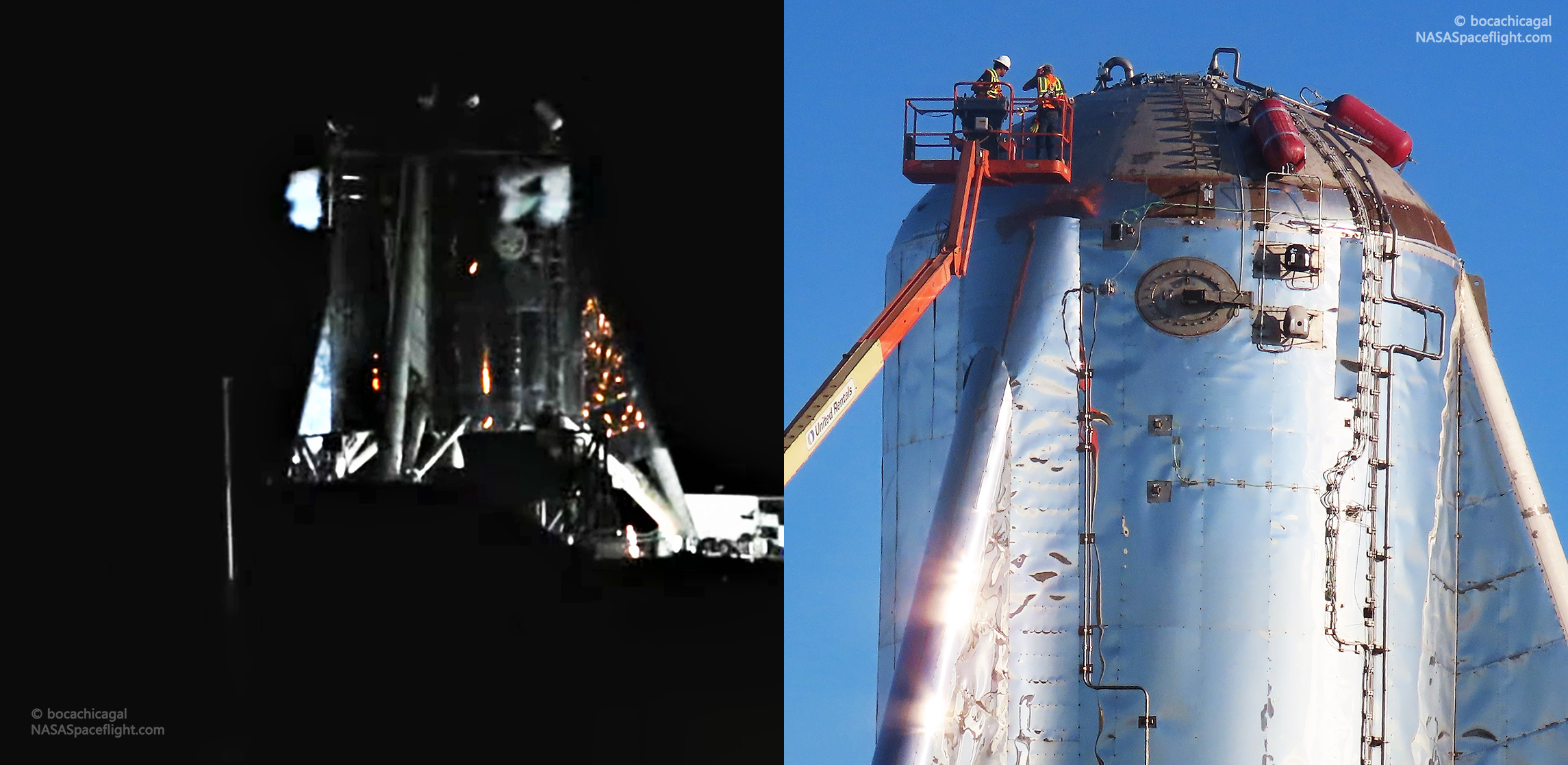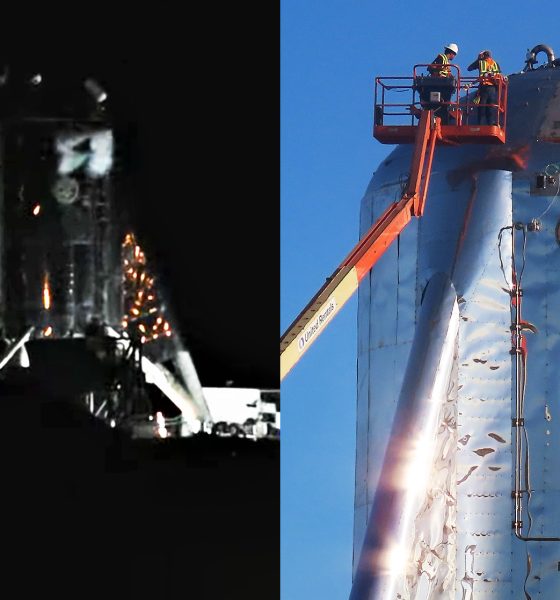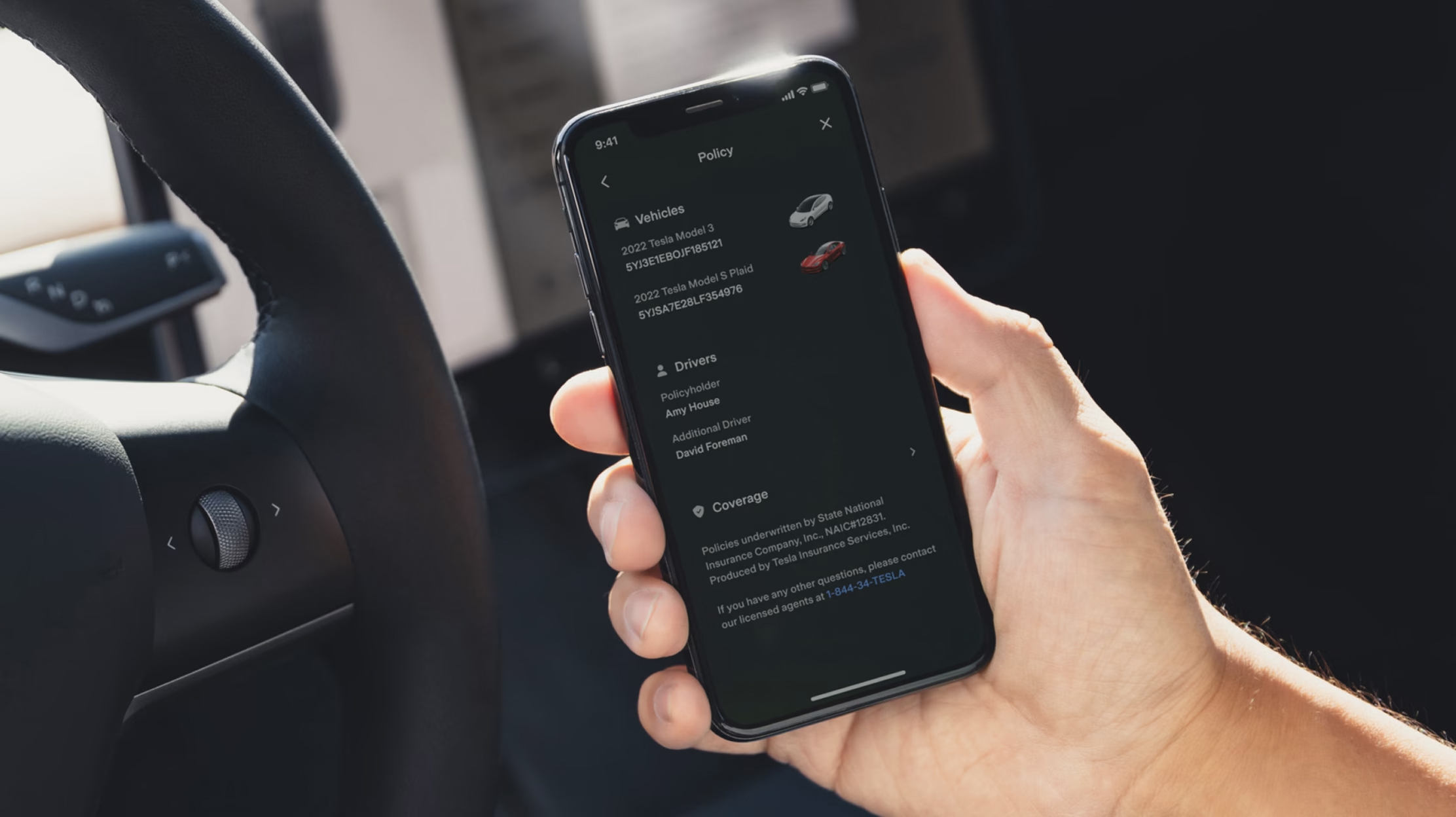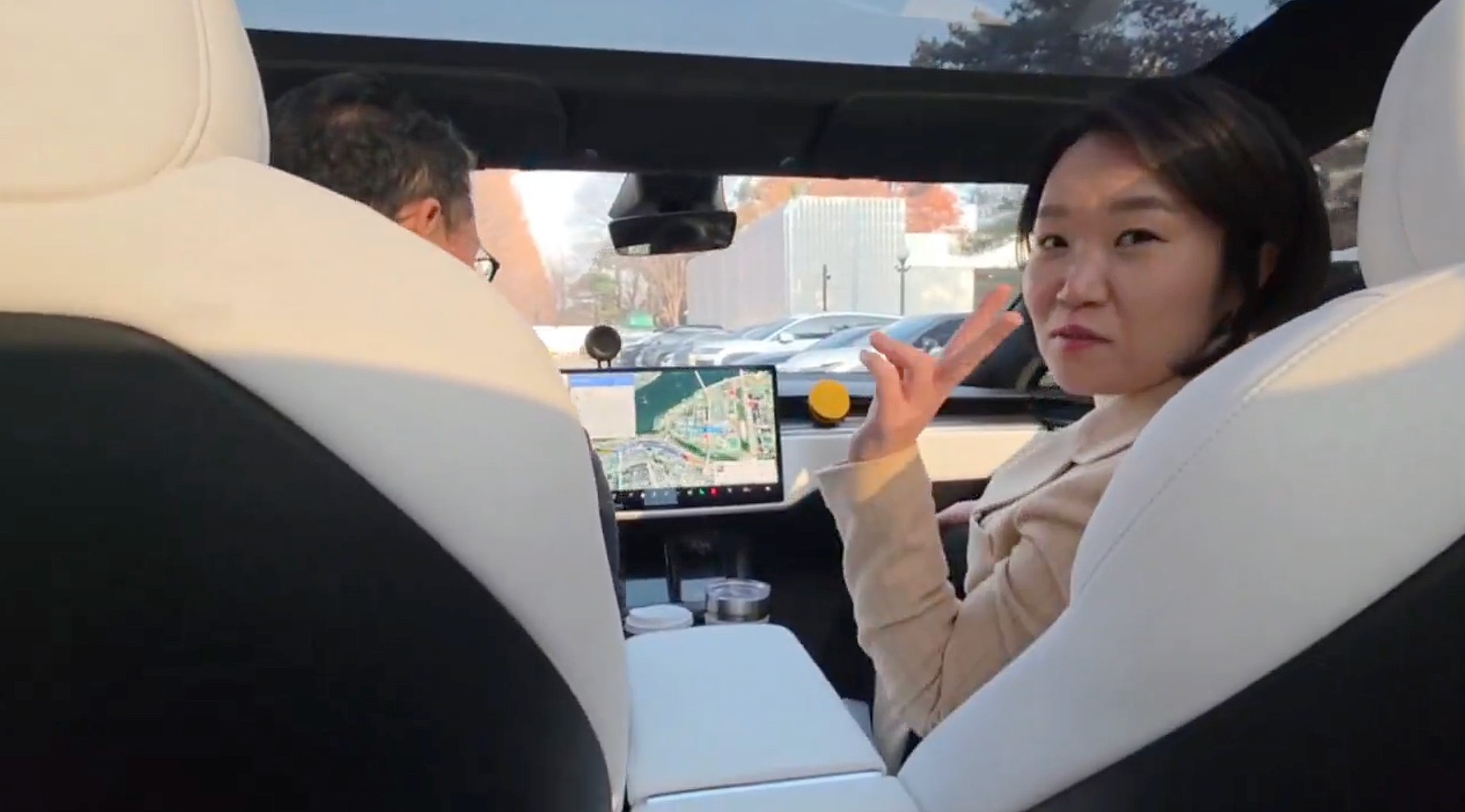

News
SpaceX tests Starhopper’s maneuvering thrusters ahead of inaugural flight test
Late at night on July 22nd, SpaceX’s South Texas team of technicians and engineers were busy testing a small but critical component of Starhopper, a testbed and low-fidelity Starship prototype meant to attempt its first untethered flight test as early as July 24th.
Monday evening’s testing centered around Starhopper’s cold gas nitrogen thrusters, multi-nozzle assemblies that appear to have quite literally been taken off of flight-proven Falcon 9 boosters. For Starhopper, they will act in a similar – albeit significantly reduced – fashion, serving to control the giant steel prototype’s attitude and augment its lone Raptor engine’s own thrust vectoring (i.e. steering) capability.
Although SpaceX has never released official numbers for the thrust of the cold gas thrusters used on Falcon 9 boosters and upper stages, it’s safe to say from their performance that the low-efficiency nitrogen thrusters produce roughly 5 kN (~1100 lbf) of thrust, perhaps up to 10+ kN. For an almost empty Falcon 9 booster, this translates to extremely rapid (sub-10s) flip maneuvers during return-to-launch-site (RTLS) landings.
At the same time, Falcon boosters have two sizes of cold-gas thrusters, with much larger high-performance (>10 kN) pods – located on the larger of the booster’s two raceways – focused on settling the rocket’s propellant after recovery-related coast periods. A duo of smaller 3-axis pods situated on the outside of the interstage serve as true attitude control system (ACS) thrusters, precisely pointing, flipping, and orienting boosters during vacuum operations and partially augmenting grid fin control authority during the late stages of landings. Despite their much smaller size, they still pack an impressive punch and are famous for almost saving tipping Falcon boosters during early (failed) landing attempts.
Starhopper, meanwhile, is dramatically larger than the Falcon 9 and Heavy boosters its tacked-on ACS thruster pods were designed for. It’s hard to know for sure but safe estimates peg the testbed’s dry mass somewhere around 50-75 metric tons (110,000-165,000 lb) thanks to the thick steel it was constructed out of. In other words, Starhopper likely weighs at least twice as much as an empty Falcon 9 booster (~25 metric tons).
To alleviate this mismatch, SpaceX arrived at a hilariously simple and cheap solution: install double the number of grave-robbed Falcon 9 thruster pods on Starhopper and voila! It was that duo of thruster pod pairs that were tested on July 22nd, visibly producing four distinct jets of pressurized nitrogen gas. Whenever Starhopper gets to hopping, those ACS thrusters should help the rocket precisely control its rotation, attitude, and – to a lesser extent – translation, hopefully helping to ensure a successful inaugural hover and divert test.
Scheduled to occur no earlier than Wednesday, July 24th, SpaceX plans to deconflict Cargo Dragon’s CRS-18 launch and Starhopper’s hover test, meaning that they will not happen simultaneously. In the ~70%-likely event that bad Florida weather delays CRS-18 to Thursday, July 25th, the road before Starhopper will be clear for an attempted hover on the 24th. Additionally, also reported first by NASASpaceflight.com, the test is expected to involve a divert, meaning that Starhopper will lift off, hover roughly 20m (65 ft) off the ground, and then carefully travel a few hundred feet East to a recently-constructed concrete pad for a soft landing.
Note they will want to deconflict with CRS-18, so if that launch is still on (dodgy weather) then perhaps hours before, or after launch? OR, *personal wish!!* go from CRS-18 webcast and then pad cameras at Boca Chica on the SpaceX webcast! ?➡️?— Chris B – NSF (@NASASpaceflight) July 23, 2019
This divert was tacitly confirmed by the arrival of a robotic transport mechanism, already used once before to move Starhopper from its build site to the launch pad. If the divert goes as planned, the transport equipment will be used to return Starhopper to its spartan launch mount and ground support equipment (GSE) umbilicals.
If Starhopper survives and Raptor SN06 performs nominally, it’s all but certain that the testbed rocket will be put through a series of increasingly ambitious test flights over the coming months – at least before SpaceX’s first higher-fidelity “Mk 1” Starship prototypes begin their own flight tests. According to CEO Elon Musk, those Starship test hops and flights could begin as few as 2-3 months from now – September or October 2019.
Check out Teslarati’s Marketplace! We offer Tesla accessories, including for the Tesla Cybertruck and Tesla Model 3.

News
Tesla Insurance officially expands to new U.S. state
Tesla’s in-house Insurance program first launched back in late 2019, offering a new way to insure the vehicles that was potentially less expensive and could alleviate a lot of the issues people had with claims, as the company could assess and repair the damage itself.

Tesla Insurance has officially expanded to a new U.S. state, its thirteenth since its launch in 2019.
Tesla has confirmed that its in-house Insurance program has officially made its way to Florida, just two months after the company filed to update its Private Passenger Auto program in the state. It had tried to offer its insurance program to drivers in the state back in 2022, but its launch did not happen.
Instead, Tesla refiled the paperwork back in mid-October, which essentially was the move toward initiating the offering this month.
BREAKING: Tesla Insurance has just officially launched in Florida.
This is the first new state to receive @Tesla Insurance in more than 3 years. In total, Tesla insurance is now available in 13 U.S. states (map in thread below of all the states).
Tesla Insurance in Florida uses… pic.twitter.com/bDwh1IV6gD
— Sawyer Merritt (@SawyerMerritt) December 17, 2025
Tesla’s in-house Insurance program first launched back in late 2019, offering a new way to insure the vehicles that was potentially less expensive and could alleviate a lot of the issues people had with claims, as the company could assess and repair the damage itself.
It has expanded to new states since 2019, but Florida presents a particularly interesting challenge for Tesla, as the company’s entry into the state is particularly noteworthy given its unique insurance landscape, characterized by high premiums due to frequent natural disasters, dense traffic, and a no-fault system.
Annual average premiums for Florida drivers hover around $4,000 per year, well above the national average. Tesla’s insurance program could disrupt this, especially for EV enthusiasts. The state’s growing EV adoption, fueled by incentives and infrastructure development, aligns perfectly with Tesla’s ecosystem.
Moreover, there are more ways to have cars repaired, and features like comprehensive coverage for battery damage and roadside assistance tailored to EVs address those common painpoints that owners have.
However, there are some challenges that still remain. Florida’s susceptibility to hurricanes raises questions about how Tesla will handle claims during disasters.
Looking ahead, Tesla’s expansion of its insurance program signals the company’s ambition to continue vertically integrating its services, including coverage of its vehicles. Reducing dependency on third-party insurers only makes things simpler for the company’s automotive division, as well as for its customers.
News
Tesla Full Self-Driving gets sparkling review from South Korean politician
“Having already ridden in an unmanned robotaxi, the novelty wasn’t as strong for me, but it drives just as well as most people do. It already feels like a completed technology, which gives me a lot to think about.”

Tesla Full Self-Driving got its first sparkling review from South Korean politician Lee So-young, a member of the country’s National Assembly, earlier this week.
Lee is a member of the Strategy and Finance Committee in South Korea and is a proponent of sustainable technologies and their applications in both residential and commercial settings. For the first time, Lee was able to utilize Tesla’s Full Self-Driving technology as it launched in the country in late November.
Her thoughts on the suite were complimentary to the suite, stating that “it drives just as well as most people do,” and that “it already feels like a completed technology.”
드디어 오늘, 서울에서 테슬라 FSD 체험 했습니다.
JiDal Papa님의 모델S 협찬에 힘입어^^ 파파님 정말 감사합니다.
국회 -> 망원시장 -> 홍익대 -> 국회 복귀 코스였고요.
이미 무인 로보택시를 타봐서 그런지 신기함은
덜했지만, 웬만한 사람만큼 운전을 잘하네요.이미 완성된 기술이라고… pic.twitter.com/8pAidHBpRG
— 이소영 국회의원 (Soyoung Lee) (@im_soyounglee) December 17, 2025
Her translated post says:
“Finally, today I got to experience Tesla FSD in Seoul. Thanks to the Model S sponsored by JiDal Papa^^, I’m truly grateful to Papa. The route was from the National Assembly -> Mangwon Market -> Hongik University -> back to the National Assembly. Having already ridden in an unmanned robotaxi, the novelty wasn’t as strong for me, but it drives just as well as most people do. It already feels like a completed technology, which gives me a lot to think about. Once it actually spreads into widespread use, I feel like our daily lives are going to change a lot. Even I, with my license gathering dust in a drawer, don’t see much reason to learn to drive a manual anymore.”
Tesla Full Self-Driving officially landed in South Korea in late November, with the initial launch being one of Tesla’s most recent, v14.1.4.
It marked the seventh country in which Tesla was able to enable the driver assistance suite, following the United States, Puerto Rico, Canada, China, Mexico, Australia, and New Zealand.
It is important to see politicians and figures in power try new technologies, especially ones that are widely popular in other regions of the world and could potentially revolutionize how people travel globally.
News
Tesla dispels reports of ‘sales suspension’ in California
“This was a “consumer protection” order about the use of the term “Autopilot” in a case where not one single customer came forward to say there’s a problem.
Sales in California will continue uninterrupted.”

Tesla has dispelled reports that it is facing a thirty-day sales suspension in California after the state’s Department of Motor Vehicles (DMV) issued a penalty to the company after a judge ruled it “misled consumers about its driver-assistance technology.”
On Tuesday, Bloomberg reported that the California DMV was planning to adopt the penalty but decided to put it on ice for ninety days, giving Tesla an opportunity to “come into compliance.”
Tesla enters interesting situation with Full Self-Driving in California
Tesla responded to the report on Tuesday evening, after it came out, stating that this was a “consumer protection” order that was brought up over its use of the term “Autopilot.”
The company said “not one single customer came forward to say there’s a problem,” yet a judge and the DMV determined it was, so they want to apply the penalty if Tesla doesn’t oblige.
However, Tesla said that its sales operations in California “will continue uninterrupted.”
It confirmed this in an X post on Tuesday night:
This was a “consumer protection” order about the use of the term “Autopilot” in a case where not one single customer came forward to say there’s a problem.
Sales in California will continue uninterrupted.
— Tesla North America (@tesla_na) December 17, 2025
The report and the decision by the DMV and Judge involved sparked outrage from the Tesla community, who stated that it should do its best to get out of California.
One X post said California “didn’t deserve” what Tesla had done for it in terms of employment, engineering, and innovation.
Tesla has used Autopilot and Full Self-Driving for years, but it did add the term “(Supervised)” to the end of the FSD suite earlier this year, potentially aiming to protect itself from instances like this one.
This is the first primary dispute over the terminology of Full Self-Driving, but it has undergone some scrutiny at the federal level, as some government officials have claimed the suite has “deceptive” naming. Previous Transportation Secretary Pete Buttigieg was vocally critical of the use of the name “Full Self-Driving,” as well as “Autopilot.”








